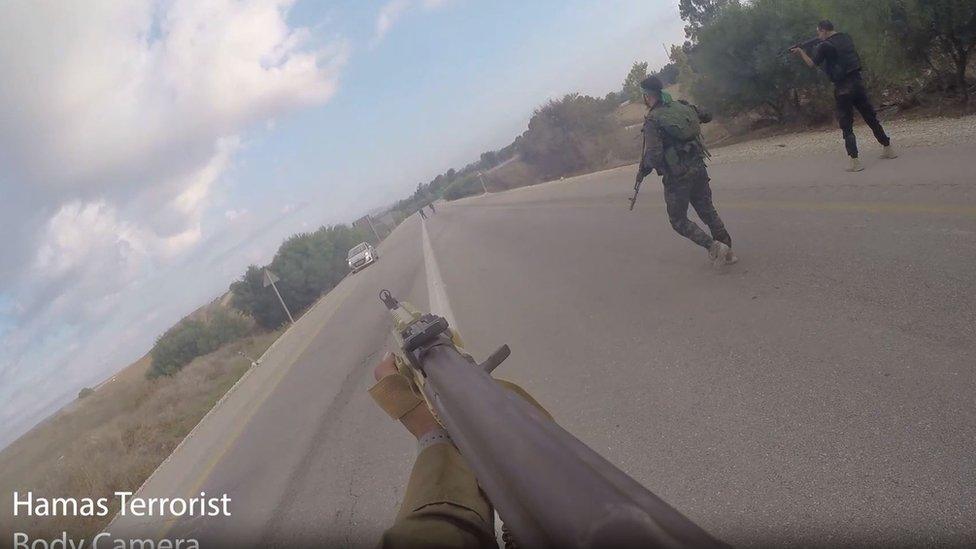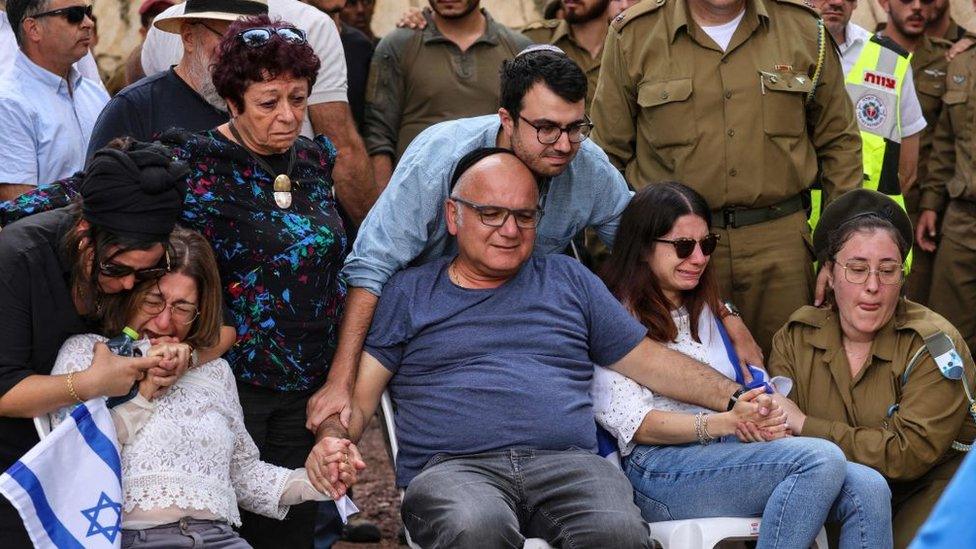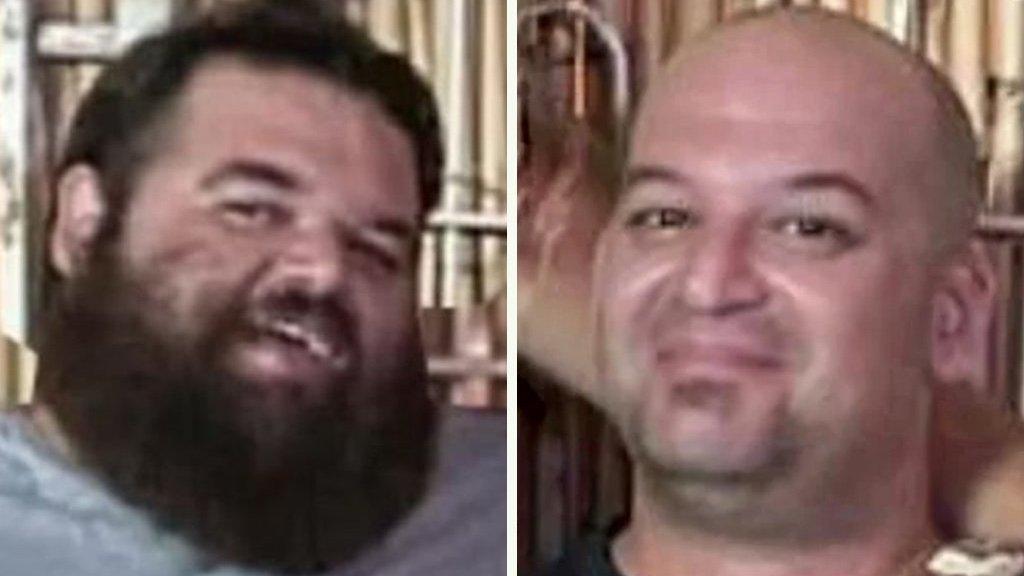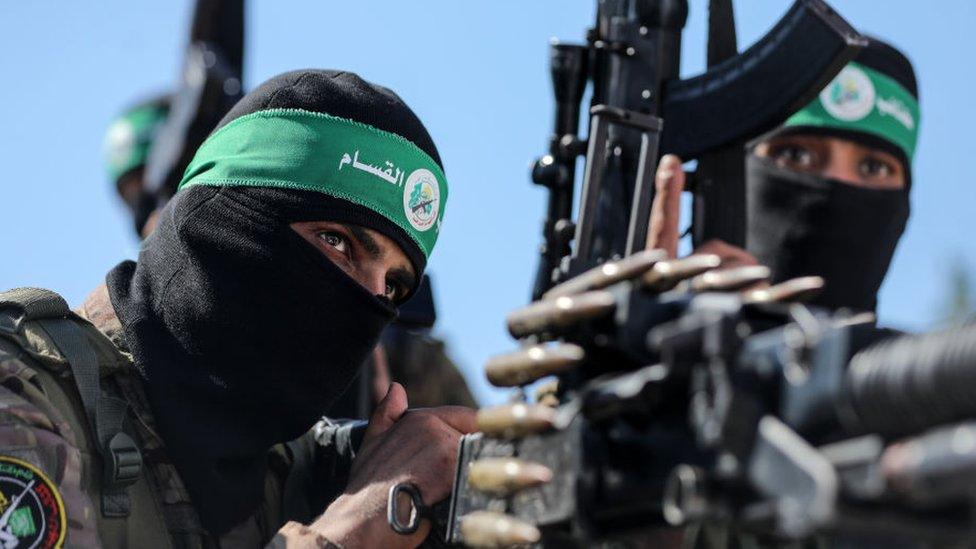Israel shows Hamas bodycam attack footage to journalists
- Published

The Israeli military screened footage taken from bodycams worn by Hamas, CCTV, dashboard cameras and mobile phones
This article contains descriptions of violence which some readers may find distressing.
The Israeli military held a screening for journalists on Monday of raw footage recovered from Hamas body cameras, in an effort to remind the world of the brutality of the attack on Israel two weeks ago.
The bodycam footage, cut together with clips from CCTV, dashboard cameras and the mobile phones of both Hamas gunmen and victims, showed in stark detail the sheer horror visited on a music festival and family neighbourhoods in southern Israel.
The Israeli military also released documents which it said were recovered from dead Hamas members, containing detailed operational planning and instructions for attacking the neighbourhoods and taking hostages.
The 43 minutes of footage screened at a military base near Tel Aviv on Monday was distilled from hundreds of hours collected since the attack, the Israeli military said. It contained clips of Hamas gunmen cheering with apparent joy as they shot civilians on the road, and later stalking the pathways of kibbutzim and killing parents and children in their homes.
One traumatic sequence, taken from home cameras inside of a kibbutz, showed a father rushing his two young boys into an above ground shelter, seconds before Hamas attackers threw a grenade in, killing the father and wounding the boys.
After the two boys, bloodied and in shock, had staggered back into their home screaming, a Hamas gunman calmly entered and looked through the fridge in front of them, pausing to take a drink before walking out again.
One of the boys cried to his brother: "Daddy is dead, this is not a prank," and repeated "Why am I alive?" His brother was apparently blinded by the grenade. The military spokesman present at the screening was unable to say whether they survived.

Dashcam footage showed the moment Hamas gunmen fired at a civilian car, cracking the windscreen
The film also contained an audio recording of one of the Hamas gunmen calling home to his parents in Gaza from the phone of a victim to boast that he had "killed at least 10 Jews with my bare hands".
"Please open WhatsApp and look how many dead," he implored his parents repeatedly, apparently referring to pictures or video he had sent home showing the attack. "Your son killed so many Jews," he said. "Mum, your son is a hero."
WARNING: The following paragraphs contain graphic descriptions of violence
Another sequence showed one Hamas gunman shooting the apparently dead bodies of civilians inside a kibbutz in a celebratory manner, and an attempt to decapitate someone who appeared to be still alive using a garden hoe.
The footage, some taken from mobile phones of victims, also showed the abject fear of those who hid in safe rooms and shelters as the sounds of gunfire and explosions came closer.
The decision to screen the raw footage for journalists reflected an apparent frustration among senior ranks of the Israeli military that the media coverage of Hamas's brutal attack on 7 October had given way to coverage of Israel's air strikes against Gaza and the humanitarian crisis created by Israel's order for Gazans to migrate south.
Speaking to the assembled international media after the screening, Major General Michael Edelstein, a former IDF Gaza division commander, said he had been "shocked" by the coverage.
"We see that some of the channels are trying to compare what Israel is doing and what those vile terrorists are doing," General Edelstein said.
"I cannot understand anyone who compares," he said. "And after what we have shared with you, you should know it."
More than 1,400 Israelis have been killed since the Hamas attack on 7 October, according to Israeli authorities - the vast majority in the initial assault. More than 220 are believed to have been taken hostage inside Gaza.
The Hamas-run health ministry in Gaza says more than 5,000 Palestinians have been killed since Israel's air strikes began in response, and according to the Palestinian health ministry in the occupied West Bank, 91 Palestinians have been killed there since 7 October.

More than 1,400 Israelis were killed when Hamas attacked communities in the south of Israel, near the Gaza Strip
After the screening of the footage on Monday, a virtual reality experience was available, created using video from the first responders who entered family homes in the kibbutzim targeted by Hamas.
The Israeli military also released two instruction manuals taken from dead Hamas gunmen, containing detailed plans for the attack and for taking hostages.
"They must shoot down as many victims as possible, take hostages and take some of them to the Gaza Strip using various cars," said one part of the manual.
In a separate document specifically about hostages, the Hamas operatives were instructed to "kill the problematic and those who pose a threat" and gather others together to use as "cannon fodder".
Israel's military is still reeling from the 7 October attack, the worst breach of its defences in the south in 50 years. Despite huge resources being put into destroying Hamas tunnels and expanding Israel's security fence both below ground and out to sea, Hamas was able to storm and breach the fence in huge numbers.
More than 1,000 militants crossed into Israel in the initial incursion, General Edelstein said on Monday. The first parts of the video compilation showed groups of pick-up trucks packed with Hamas gunmen, driving freely along Israeli highways and shooting civilians at will.
The documents recovered from the bodies of the Hamas militants made it clear that Hamas "came with orders to slaughter and burn citizens", General Edelstein said.
"They simply decided to burn families within their homes. And they took hostages alive, they were aiming to take children back into Gaza," he said.
"Orders were there for how many to kill, how many to take as hostages. Orders were there to rape, all was written and ordered."
Speaking before the screening, Israeli military spokesman Rear Admiral Daniel Hagari said that members of the military had debated whether to show the footage, but that he had decided personally to go ahead.
"We understand already that we need to create a collective memory for the future," he said. "We will not let the world forget."

More on Israel-Gaza war
Follow live: Latest updates
Explained: What is happening in Israel and Gaza, and why now?
History behind the story: The Israel-Palestinian conflict

Related topics
- Published27 February

